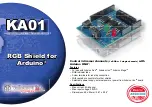After a repeated START condition (Sr), all other slave devices also compare the first
seven bits of the first byte of the slave address with their own addresses and test the
eighth (R/W) bit. However, none of them are addressed because R/W = 1 (for 10-bit
devices), or the 11110XX slave address (for 7-bit devices) does not match.
Table 30-31. Master-receiver addresses a slave-transmitter with a 10-bit
address
S
Slave
address
first 7
bits
11110 +
AD10 +
AD9
R/W
0
A1
Slave
address
second
byte
AD[8:1]
A2
Sr
Slave
address
first 7
bits
11110 +
AD10 +
AD9
R/W
1
A3
Data
A
...
Data
A
P
After the master-receiver has sent the first byte of the 10-bit address, the slave-transmitter
sees an I2C interrupt. User software must ensure that for this interrupt, the contents of the
Data register are ignored and not treated as valid data.
30.4.3 Address matching
All received addresses can be requested in 7-bit or 10-bit address format.
• AD[7:1] in Address Register 1, which contains the I2C primary slave address, always
participates in the address matching process. It provides a 7-bit address.
• If the ADEXT bit is set, AD[10:8] in Control Register 2 participates in the address
matching process. It extends the I2C primary slave address to a 10-bit address.
Additional conditions that affect address matching include:
• If the GCAEN bit is set, general call participates the address matching process.
• If the Range Address register is programmed to a nonzero value, the range address
itself participates in the address matching process.
• If the RMEN bit is set, any address within the range of values of Address Register 1
and the Range Address register participates in the address matching process. The
Range Address register must be programmed to a value greater than the value of
Address Register 1.
When the I2C module responds to one of these addresses, it acts as a slave-receiver and
the IAAS bit is set after the address cycle. Software must read the Data register after the
first byte transfer to determine that the address is matched.
Chapter 30 Inter-Integrated Circuit (I2C)
KL02 Sub-Family Reference Manual, Rev. 2.1, July 2013
Freescale Semiconductor, Inc.
489


















